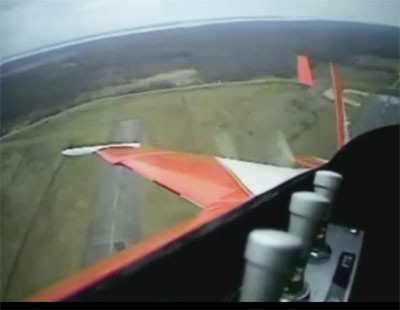Wed, May 30, 2007
Technology Holds Promise For Many Types Of Aircraft
Athena Technologies announced Wednesday the successful flight
demonstration of damage tolerant flight control and autonomous
landing capabilities on a subscale F/A-18 UAV. The Defense Advanced
Research Projects Agency (DARPA) sponsored the demonstration, which
was held on April 18, 2007 at the Aberdeen Proving Grounds in
Maryland.

The objective of the test was to prove that adaptive flight
controls could regain baseline aircraft performance after the
aircraft had sustained simulated battle damage and then safely land
the aircraft autonomously with only the onboard INS/GPS
functionality of Athena's GuideStar 111m for navigation.
The demonstration involved a subscale F/A-18 UAV, powered by a
turbojet engine, that sustained wing battle damage simulated with
the in-flight ejection of an aileron (shown above). Athena's damage
tolerant controls detected the damage in flight and adapted to the
new air vehicle configuration for the effects of the lost aileron,
recovering the baseline vehicle performance.
The vehicle then successfully landed in the damaged state with
Athena's INS/GPS-only autonomous landing system within a few feet
of the target touch down point on the airfield runway.
Damage tolerance is an enabling capability for increasing the
mission reliability of UAVs and Unmanned Combat Air Vehicles
(UCAVs) operating in hazardous and high-threat environments. The
technology provides for real-time autonomous accommodation of
damage, followed by an adaptation process that alters the flight
control system to compensate for the effects of the damage. During
the flight test, Athena demonstrated a capability that could be
applicable to all military aircraft operating in combat
environments. The technology is also relevant to any vehicle,
manned or unmanned, including civilian aircraft, that might sustain
physical damage or failures that impact controlled flight.
Athena tells ANN the demonstration highlights the challenge and
importance of the ability to autonomously land an air vehicle that
has sustained damage. This powerful capability can potentially save
the military the significant expense of lost UAVs and better
protect US proprietary technology.
More importantly, when applied to manned aircraft... the
combined technology solution could just save lives.
More News
Airport Marking Aids Markings used on runway and taxiway surfaces to identify a specific runway, a runway threshold, a centerline, a hold line, etc. A runway should be marked in ac>[...]
"It is extremely difficult, if not impossible, for manned aircraft to see a drone while conducting crop-enhancing and other aerial applications at low altitudes and high speeds. We>[...]
Aero Linx: The Skyhawk Association The Skyhawk Association is a non-profit organization founded by former Skyhawk Pilots which is open to anyone with an affinity for the A-4 Skyhaw>[...]
“The T-54A benefits from an active Beechcraft King Air assembly line in Wichita, Kansas, where all required METS avionics and interior modifications are installed on the line>[...]
Aero Linx: Aerostar Owners Association The Association offers the Aerostar Owner a unique opportunity to tap an invaluable source of information concerning the care and feeding of >[...]
 ANN's Daily Aero-Term (04.28.24): Airport Marking Aids
ANN's Daily Aero-Term (04.28.24): Airport Marking Aids Aero-News: Quote of the Day (04.28.24)
Aero-News: Quote of the Day (04.28.24) ANN's Daily Aero-Linx (04.28.24)
ANN's Daily Aero-Linx (04.28.24) Aero-News: Quote of the Day (04.29.24)
Aero-News: Quote of the Day (04.29.24) ANN's Daily Aero-Linx (04.29.24)
ANN's Daily Aero-Linx (04.29.24)



